Employee Collaboration Tools in UK Retail: A Tesco Case Study
VerifiedAdded on 2023/06/09
|23
|5576
|455
Report
AI Summary
This research project analyzes the employee collaboration tools used by Tesco, a major UK retailer, to manage workplace transformation. It examines various tools such as GoToMeeting, Slack, ProofHub, and Milanote, and their impact on employee productivity, including the role of incentives, open communication, and employee retention. The study also identifies challenges faced by Tesco during the implementation of workplace transformation, such as resistance to change, data security concerns, productivity issues, and a lack of IT skills among employees. The research employs a comprehensive methodology to gather and interpret information, providing insights into how employee collaboration tools can effectively support organizational change in the retail industry.
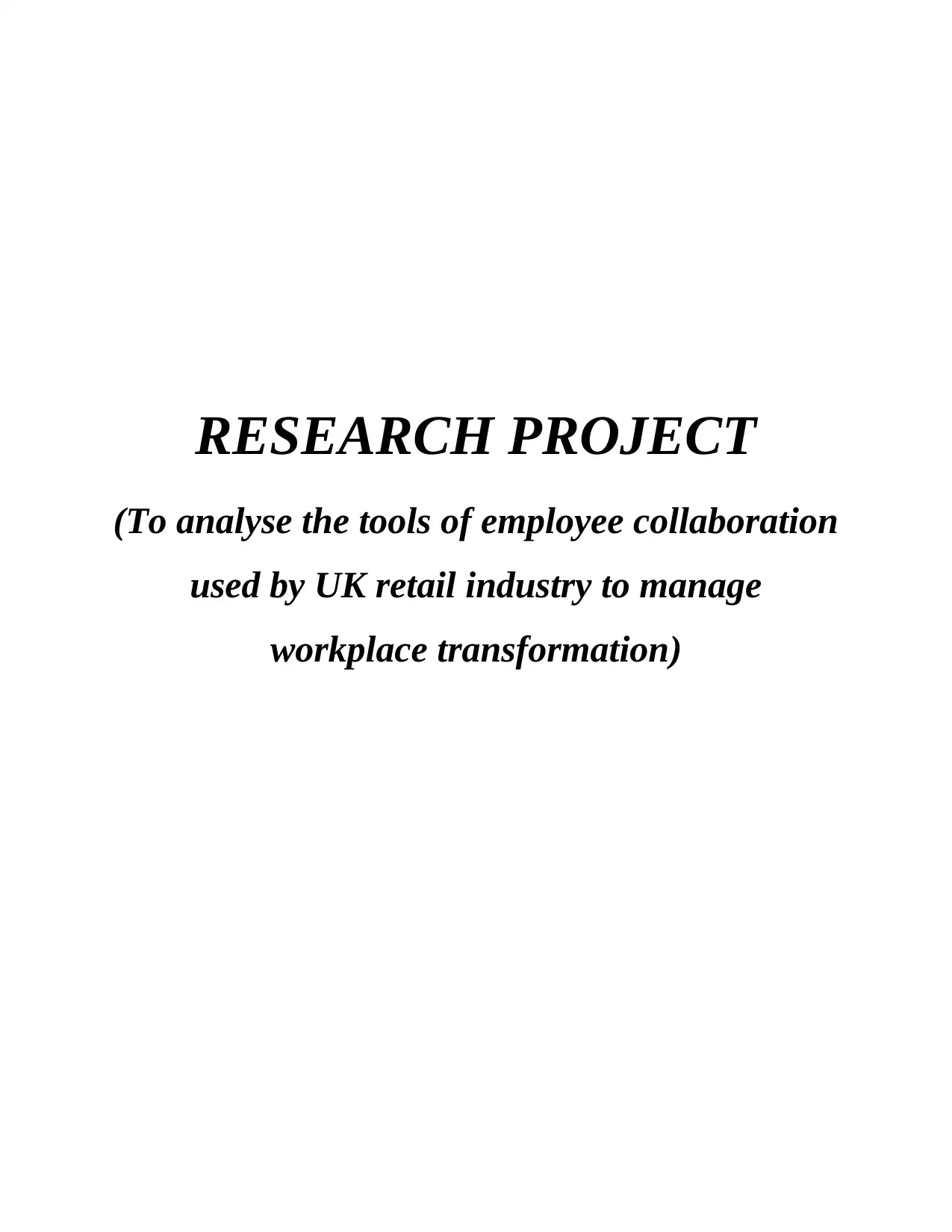
RESEARCH PROJECT
(To analyse the tools of employee collaboration
used by UK retail industry to manage
workplace transformation)
(To analyse the tools of employee collaboration
used by UK retail industry to manage
workplace transformation)
Paraphrase This Document
Need a fresh take? Get an instant paraphrase of this document with our AI Paraphraser
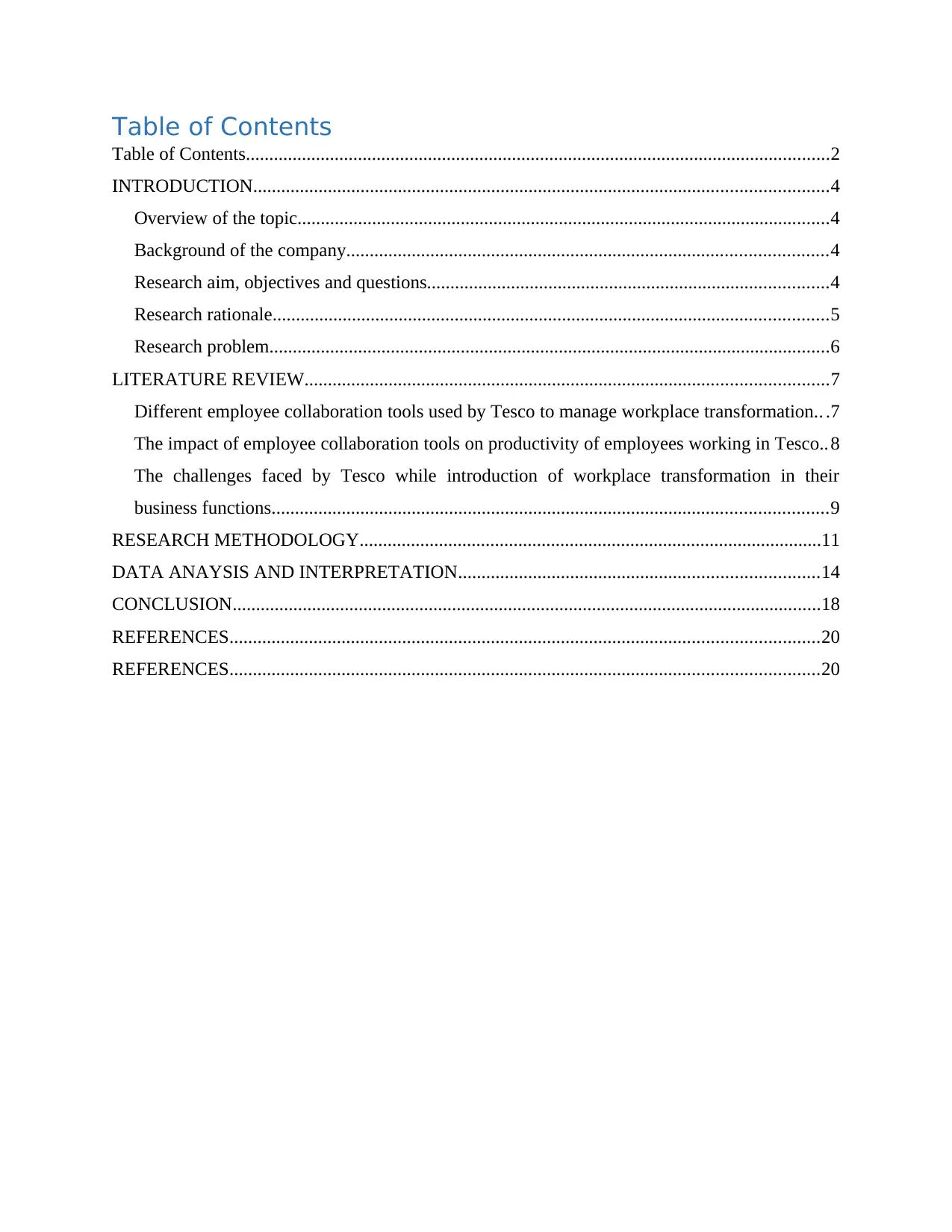
Table of Contents
Table of Contents.............................................................................................................................2
INTRODUCTION...........................................................................................................................4
Overview of the topic..................................................................................................................4
Background of the company.......................................................................................................4
Research aim, objectives and questions......................................................................................4
Research rationale.......................................................................................................................5
Research problem........................................................................................................................6
LITERATURE REVIEW................................................................................................................7
Different employee collaboration tools used by Tesco to manage workplace transformation.. .7
The impact of employee collaboration tools on productivity of employees working in Tesco..8
The challenges faced by Tesco while introduction of workplace transformation in their
business functions.......................................................................................................................9
RESEARCH METHODOLOGY...................................................................................................11
DATA ANAYSIS AND INTERPRETATION.............................................................................14
CONCLUSION..............................................................................................................................18
REFERENCES..............................................................................................................................20
REFERENCES..............................................................................................................................20
Table of Contents.............................................................................................................................2
INTRODUCTION...........................................................................................................................4
Overview of the topic..................................................................................................................4
Background of the company.......................................................................................................4
Research aim, objectives and questions......................................................................................4
Research rationale.......................................................................................................................5
Research problem........................................................................................................................6
LITERATURE REVIEW................................................................................................................7
Different employee collaboration tools used by Tesco to manage workplace transformation.. .7
The impact of employee collaboration tools on productivity of employees working in Tesco..8
The challenges faced by Tesco while introduction of workplace transformation in their
business functions.......................................................................................................................9
RESEARCH METHODOLOGY...................................................................................................11
DATA ANAYSIS AND INTERPRETATION.............................................................................14
CONCLUSION..............................................................................................................................18
REFERENCES..............................................................................................................................20
REFERENCES..............................................................................................................................20

⊘ This is a preview!⊘
Do you want full access?
Subscribe today to unlock all pages.

Trusted by 1+ million students worldwide
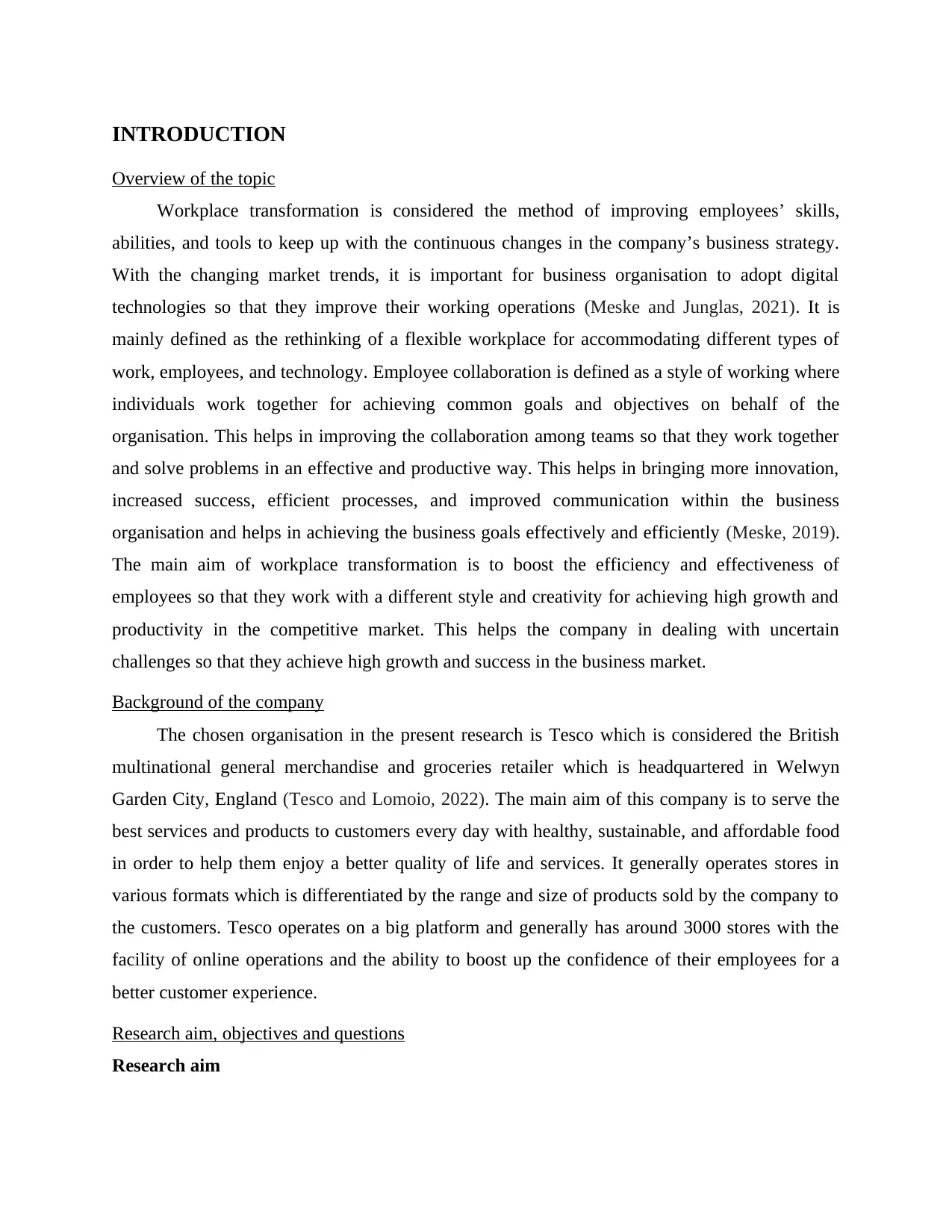
INTRODUCTION
Overview of the topic
Workplace transformation is considered the method of improving employees’ skills,
abilities, and tools to keep up with the continuous changes in the company’s business strategy.
With the changing market trends, it is important for business organisation to adopt digital
technologies so that they improve their working operations (Meske and Junglas, 2021). It is
mainly defined as the rethinking of a flexible workplace for accommodating different types of
work, employees, and technology. Employee collaboration is defined as a style of working where
individuals work together for achieving common goals and objectives on behalf of the
organisation. This helps in improving the collaboration among teams so that they work together
and solve problems in an effective and productive way. This helps in bringing more innovation,
increased success, efficient processes, and improved communication within the business
organisation and helps in achieving the business goals effectively and efficiently (Meske, 2019).
The main aim of workplace transformation is to boost the efficiency and effectiveness of
employees so that they work with a different style and creativity for achieving high growth and
productivity in the competitive market. This helps the company in dealing with uncertain
challenges so that they achieve high growth and success in the business market.
Background of the company
The chosen organisation in the present research is Tesco which is considered the British
multinational general merchandise and groceries retailer which is headquartered in Welwyn
Garden City, England (Tesco and Lomoio, 2022). The main aim of this company is to serve the
best services and products to customers every day with healthy, sustainable, and affordable food
in order to help them enjoy a better quality of life and services. It generally operates stores in
various formats which is differentiated by the range and size of products sold by the company to
the customers. Tesco operates on a big platform and generally has around 3000 stores with the
facility of online operations and the ability to boost up the confidence of their employees for a
better customer experience.
Research aim, objectives and questions
Research aim
Overview of the topic
Workplace transformation is considered the method of improving employees’ skills,
abilities, and tools to keep up with the continuous changes in the company’s business strategy.
With the changing market trends, it is important for business organisation to adopt digital
technologies so that they improve their working operations (Meske and Junglas, 2021). It is
mainly defined as the rethinking of a flexible workplace for accommodating different types of
work, employees, and technology. Employee collaboration is defined as a style of working where
individuals work together for achieving common goals and objectives on behalf of the
organisation. This helps in improving the collaboration among teams so that they work together
and solve problems in an effective and productive way. This helps in bringing more innovation,
increased success, efficient processes, and improved communication within the business
organisation and helps in achieving the business goals effectively and efficiently (Meske, 2019).
The main aim of workplace transformation is to boost the efficiency and effectiveness of
employees so that they work with a different style and creativity for achieving high growth and
productivity in the competitive market. This helps the company in dealing with uncertain
challenges so that they achieve high growth and success in the business market.
Background of the company
The chosen organisation in the present research is Tesco which is considered the British
multinational general merchandise and groceries retailer which is headquartered in Welwyn
Garden City, England (Tesco and Lomoio, 2022). The main aim of this company is to serve the
best services and products to customers every day with healthy, sustainable, and affordable food
in order to help them enjoy a better quality of life and services. It generally operates stores in
various formats which is differentiated by the range and size of products sold by the company to
the customers. Tesco operates on a big platform and generally has around 3000 stores with the
facility of online operations and the ability to boost up the confidence of their employees for a
better customer experience.
Research aim, objectives and questions
Research aim
Paraphrase This Document
Need a fresh take? Get an instant paraphrase of this document with our AI Paraphraser
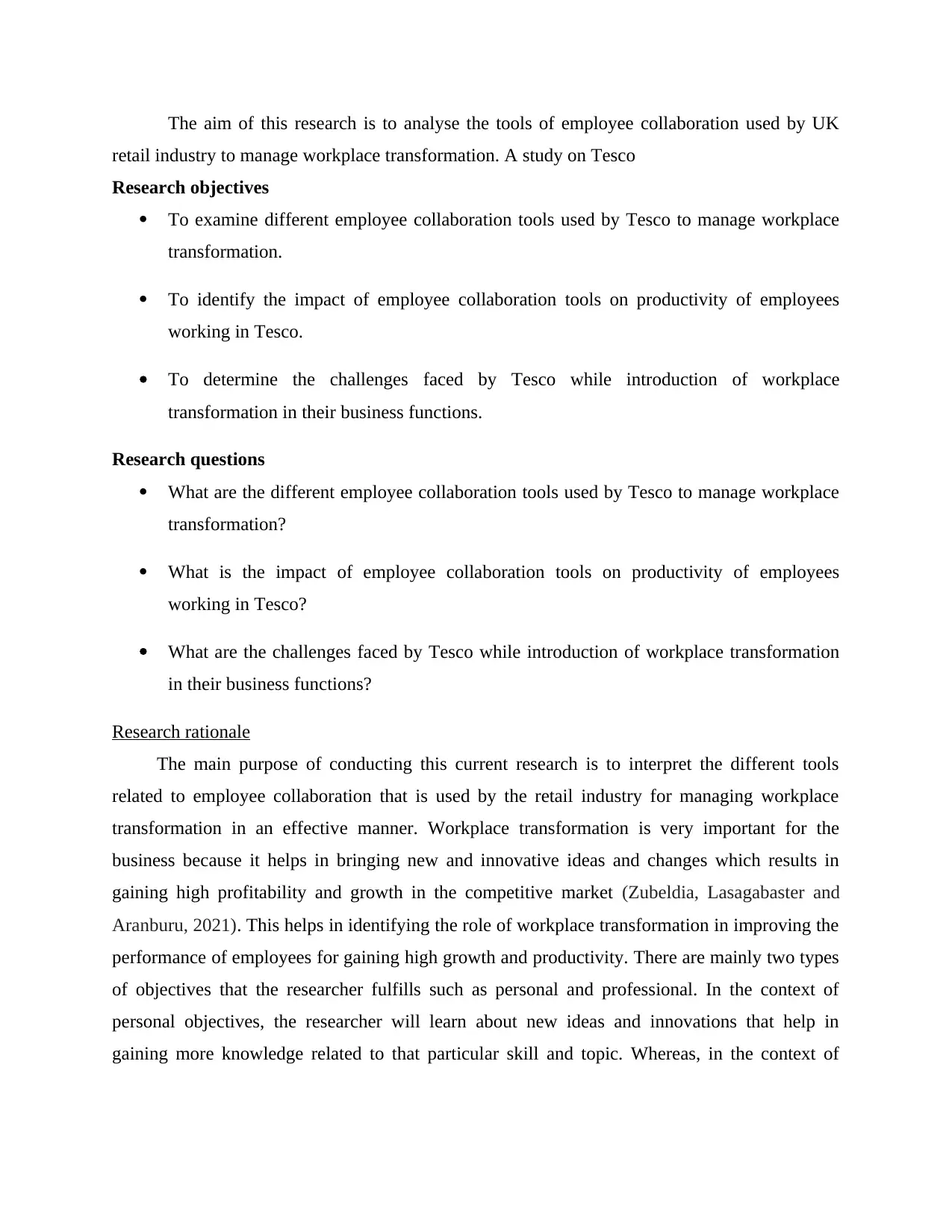
The aim of this research is to analyse the tools of employee collaboration used by UK
retail industry to manage workplace transformation. A study on Tesco
Research objectives
To examine different employee collaboration tools used by Tesco to manage workplace
transformation.
To identify the impact of employee collaboration tools on productivity of employees
working in Tesco.
To determine the challenges faced by Tesco while introduction of workplace
transformation in their business functions.
Research questions
What are the different employee collaboration tools used by Tesco to manage workplace
transformation?
What is the impact of employee collaboration tools on productivity of employees
working in Tesco?
What are the challenges faced by Tesco while introduction of workplace transformation
in their business functions?
Research rationale
The main purpose of conducting this current research is to interpret the different tools
related to employee collaboration that is used by the retail industry for managing workplace
transformation in an effective manner. Workplace transformation is very important for the
business because it helps in bringing new and innovative ideas and changes which results in
gaining high profitability and growth in the competitive market (Zubeldia, Lasagabaster and
Aranburu, 2021). This helps in identifying the role of workplace transformation in improving the
performance of employees for gaining high growth and productivity. There are mainly two types
of objectives that the researcher fulfills such as personal and professional. In the context of
personal objectives, the researcher will learn about new ideas and innovations that help in
gaining more knowledge related to that particular skill and topic. Whereas, in the context of
retail industry to manage workplace transformation. A study on Tesco
Research objectives
To examine different employee collaboration tools used by Tesco to manage workplace
transformation.
To identify the impact of employee collaboration tools on productivity of employees
working in Tesco.
To determine the challenges faced by Tesco while introduction of workplace
transformation in their business functions.
Research questions
What are the different employee collaboration tools used by Tesco to manage workplace
transformation?
What is the impact of employee collaboration tools on productivity of employees
working in Tesco?
What are the challenges faced by Tesco while introduction of workplace transformation
in their business functions?
Research rationale
The main purpose of conducting this current research is to interpret the different tools
related to employee collaboration that is used by the retail industry for managing workplace
transformation in an effective manner. Workplace transformation is very important for the
business because it helps in bringing new and innovative ideas and changes which results in
gaining high profitability and growth in the competitive market (Zubeldia, Lasagabaster and
Aranburu, 2021). This helps in identifying the role of workplace transformation in improving the
performance of employees for gaining high growth and productivity. There are mainly two types
of objectives that the researcher fulfills such as personal and professional. In the context of
personal objectives, the researcher will learn about new ideas and innovations that help in
gaining more knowledge related to that particular skill and topic. Whereas, in the context of
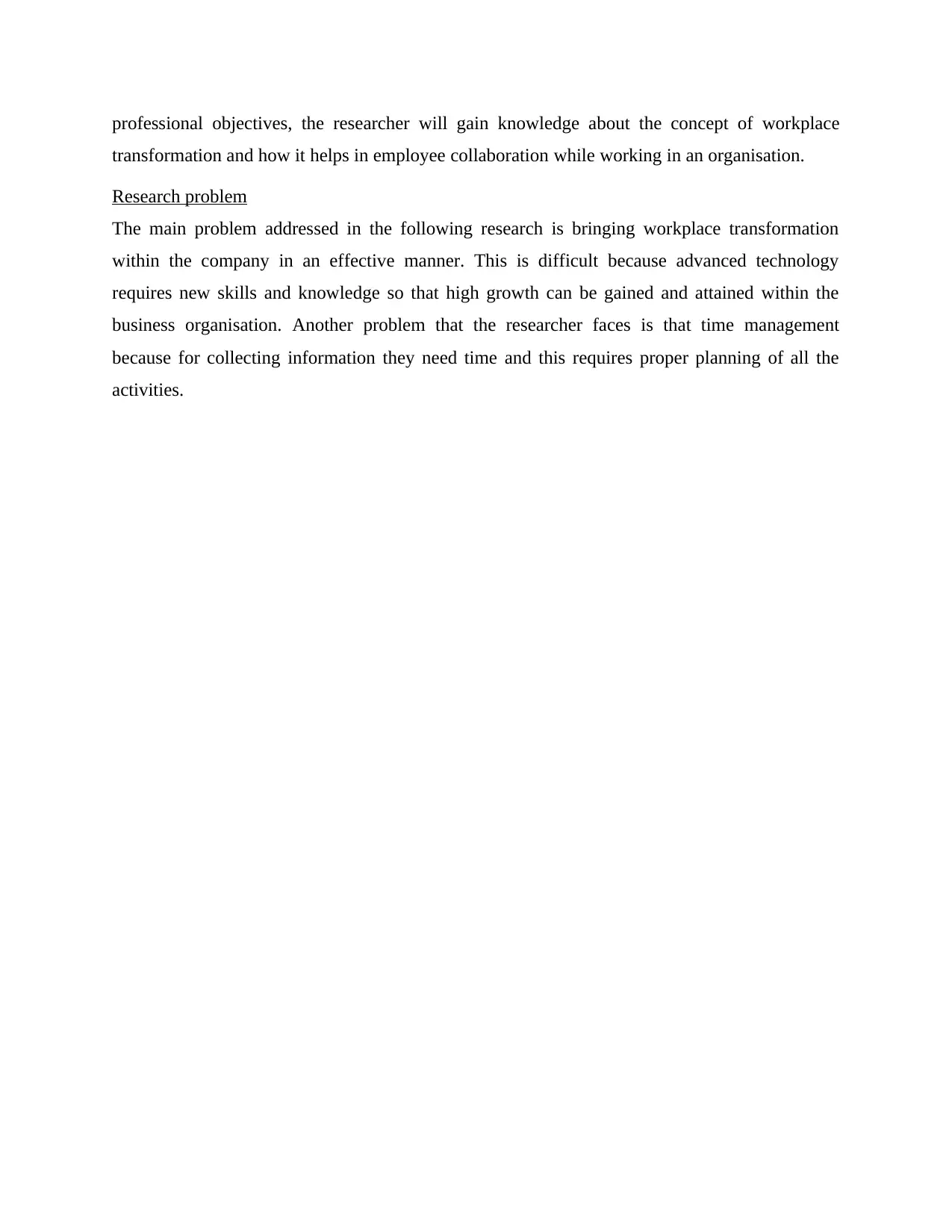
professional objectives, the researcher will gain knowledge about the concept of workplace
transformation and how it helps in employee collaboration while working in an organisation.
Research problem
The main problem addressed in the following research is bringing workplace transformation
within the company in an effective manner. This is difficult because advanced technology
requires new skills and knowledge so that high growth can be gained and attained within the
business organisation. Another problem that the researcher faces is that time management
because for collecting information they need time and this requires proper planning of all the
activities.
transformation and how it helps in employee collaboration while working in an organisation.
Research problem
The main problem addressed in the following research is bringing workplace transformation
within the company in an effective manner. This is difficult because advanced technology
requires new skills and knowledge so that high growth can be gained and attained within the
business organisation. Another problem that the researcher faces is that time management
because for collecting information they need time and this requires proper planning of all the
activities.
⊘ This is a preview!⊘
Do you want full access?
Subscribe today to unlock all pages.

Trusted by 1+ million students worldwide
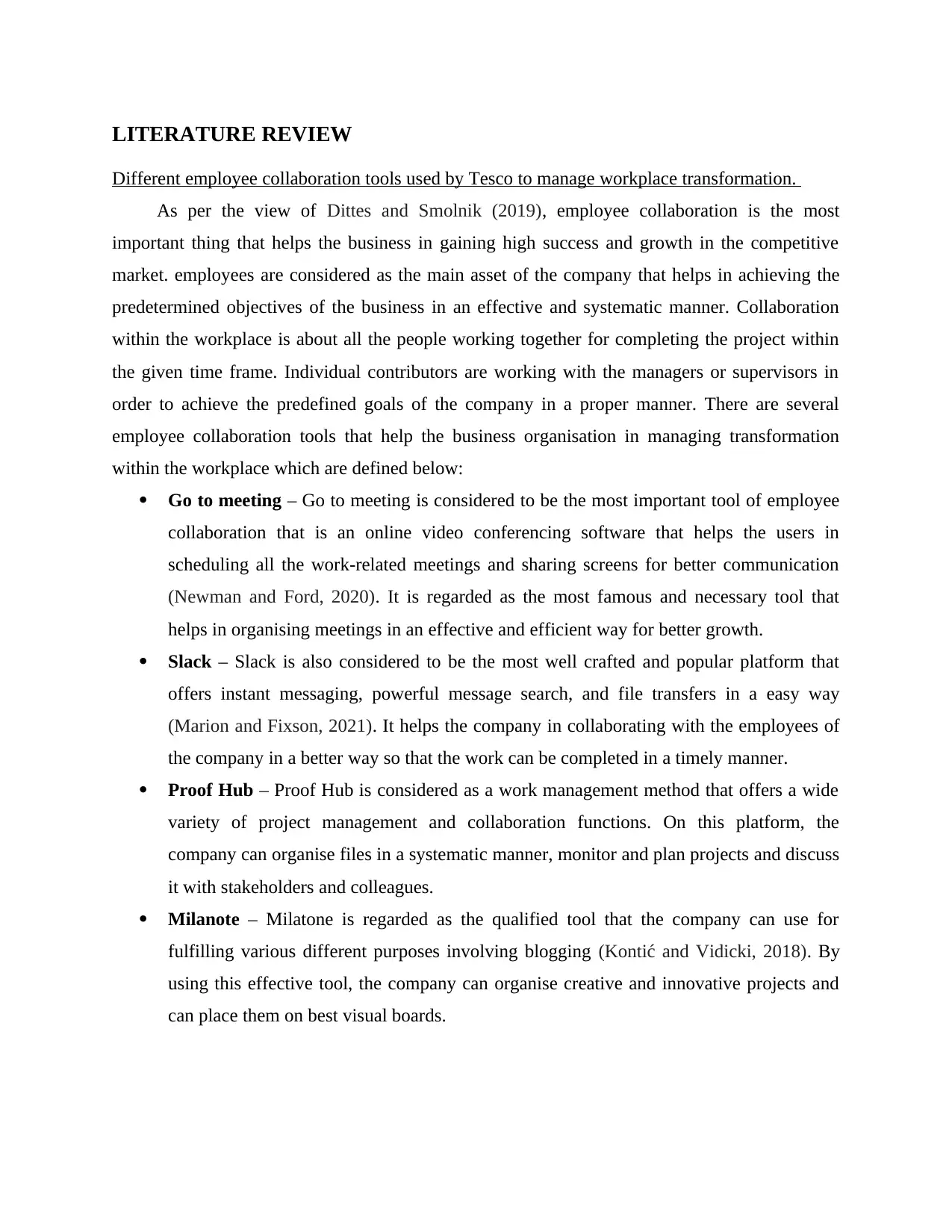
LITERATURE REVIEW
Different employee collaboration tools used by Tesco to manage workplace transformation.
As per the view of Dittes and Smolnik (2019), employee collaboration is the most
important thing that helps the business in gaining high success and growth in the competitive
market. employees are considered as the main asset of the company that helps in achieving the
predetermined objectives of the business in an effective and systematic manner. Collaboration
within the workplace is about all the people working together for completing the project within
the given time frame. Individual contributors are working with the managers or supervisors in
order to achieve the predefined goals of the company in a proper manner. There are several
employee collaboration tools that help the business organisation in managing transformation
within the workplace which are defined below:
Go to meeting – Go to meeting is considered to be the most important tool of employee
collaboration that is an online video conferencing software that helps the users in
scheduling all the work-related meetings and sharing screens for better communication
(Newman and Ford, 2020). It is regarded as the most famous and necessary tool that
helps in organising meetings in an effective and efficient way for better growth.
Slack – Slack is also considered to be the most well crafted and popular platform that
offers instant messaging, powerful message search, and file transfers in a easy way
(Marion and Fixson, 2021). It helps the company in collaborating with the employees of
the company in a better way so that the work can be completed in a timely manner.
Proof Hub – Proof Hub is considered as a work management method that offers a wide
variety of project management and collaboration functions. On this platform, the
company can organise files in a systematic manner, monitor and plan projects and discuss
it with stakeholders and colleagues.
Milanote – Milatone is regarded as the qualified tool that the company can use for
fulfilling various different purposes involving blogging (Kontić and Vidicki, 2018). By
using this effective tool, the company can organise creative and innovative projects and
can place them on best visual boards.
Different employee collaboration tools used by Tesco to manage workplace transformation.
As per the view of Dittes and Smolnik (2019), employee collaboration is the most
important thing that helps the business in gaining high success and growth in the competitive
market. employees are considered as the main asset of the company that helps in achieving the
predetermined objectives of the business in an effective and systematic manner. Collaboration
within the workplace is about all the people working together for completing the project within
the given time frame. Individual contributors are working with the managers or supervisors in
order to achieve the predefined goals of the company in a proper manner. There are several
employee collaboration tools that help the business organisation in managing transformation
within the workplace which are defined below:
Go to meeting – Go to meeting is considered to be the most important tool of employee
collaboration that is an online video conferencing software that helps the users in
scheduling all the work-related meetings and sharing screens for better communication
(Newman and Ford, 2020). It is regarded as the most famous and necessary tool that
helps in organising meetings in an effective and efficient way for better growth.
Slack – Slack is also considered to be the most well crafted and popular platform that
offers instant messaging, powerful message search, and file transfers in a easy way
(Marion and Fixson, 2021). It helps the company in collaborating with the employees of
the company in a better way so that the work can be completed in a timely manner.
Proof Hub – Proof Hub is considered as a work management method that offers a wide
variety of project management and collaboration functions. On this platform, the
company can organise files in a systematic manner, monitor and plan projects and discuss
it with stakeholders and colleagues.
Milanote – Milatone is regarded as the qualified tool that the company can use for
fulfilling various different purposes involving blogging (Kontić and Vidicki, 2018). By
using this effective tool, the company can organise creative and innovative projects and
can place them on best visual boards.
Paraphrase This Document
Need a fresh take? Get an instant paraphrase of this document with our AI Paraphraser
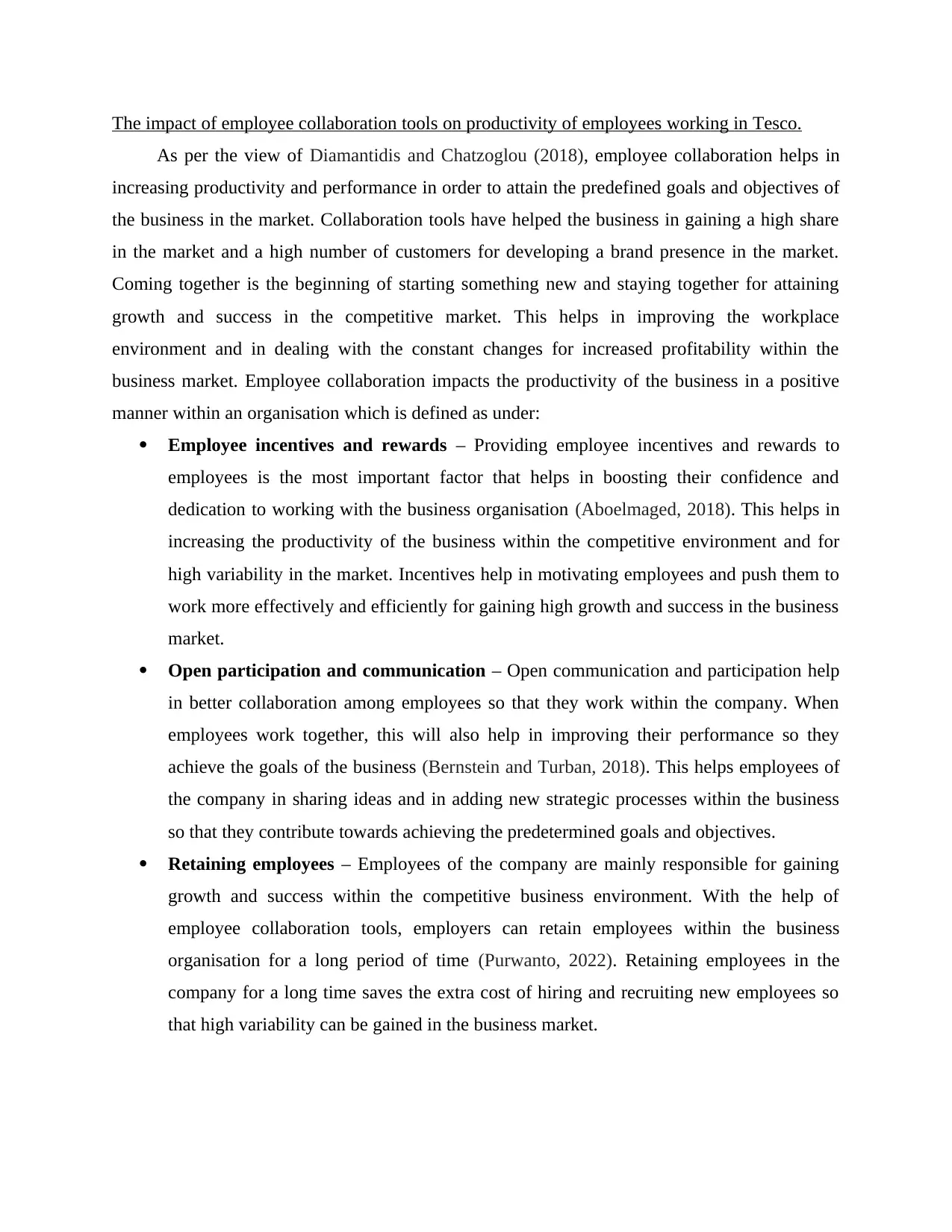
The impact of employee collaboration tools on productivity of employees working in Tesco.
As per the view of Diamantidis and Chatzoglou (2018), employee collaboration helps in
increasing productivity and performance in order to attain the predefined goals and objectives of
the business in the market. Collaboration tools have helped the business in gaining a high share
in the market and a high number of customers for developing a brand presence in the market.
Coming together is the beginning of starting something new and staying together for attaining
growth and success in the competitive market. This helps in improving the workplace
environment and in dealing with the constant changes for increased profitability within the
business market. Employee collaboration impacts the productivity of the business in a positive
manner within an organisation which is defined as under:
Employee incentives and rewards – Providing employee incentives and rewards to
employees is the most important factor that helps in boosting their confidence and
dedication to working with the business organisation (Aboelmaged, 2018). This helps in
increasing the productivity of the business within the competitive environment and for
high variability in the market. Incentives help in motivating employees and push them to
work more effectively and efficiently for gaining high growth and success in the business
market.
Open participation and communication – Open communication and participation help
in better collaboration among employees so that they work within the company. When
employees work together, this will also help in improving their performance so they
achieve the goals of the business (Bernstein and Turban, 2018). This helps employees of
the company in sharing ideas and in adding new strategic processes within the business
so that they contribute towards achieving the predetermined goals and objectives.
Retaining employees – Employees of the company are mainly responsible for gaining
growth and success within the competitive business environment. With the help of
employee collaboration tools, employers can retain employees within the business
organisation for a long period of time (Purwanto, 2022). Retaining employees in the
company for a long time saves the extra cost of hiring and recruiting new employees so
that high variability can be gained in the business market.
As per the view of Diamantidis and Chatzoglou (2018), employee collaboration helps in
increasing productivity and performance in order to attain the predefined goals and objectives of
the business in the market. Collaboration tools have helped the business in gaining a high share
in the market and a high number of customers for developing a brand presence in the market.
Coming together is the beginning of starting something new and staying together for attaining
growth and success in the competitive market. This helps in improving the workplace
environment and in dealing with the constant changes for increased profitability within the
business market. Employee collaboration impacts the productivity of the business in a positive
manner within an organisation which is defined as under:
Employee incentives and rewards – Providing employee incentives and rewards to
employees is the most important factor that helps in boosting their confidence and
dedication to working with the business organisation (Aboelmaged, 2018). This helps in
increasing the productivity of the business within the competitive environment and for
high variability in the market. Incentives help in motivating employees and push them to
work more effectively and efficiently for gaining high growth and success in the business
market.
Open participation and communication – Open communication and participation help
in better collaboration among employees so that they work within the company. When
employees work together, this will also help in improving their performance so they
achieve the goals of the business (Bernstein and Turban, 2018). This helps employees of
the company in sharing ideas and in adding new strategic processes within the business
so that they contribute towards achieving the predetermined goals and objectives.
Retaining employees – Employees of the company are mainly responsible for gaining
growth and success within the competitive business environment. With the help of
employee collaboration tools, employers can retain employees within the business
organisation for a long period of time (Purwanto, 2022). Retaining employees in the
company for a long time saves the extra cost of hiring and recruiting new employees so
that high variability can be gained in the business market.
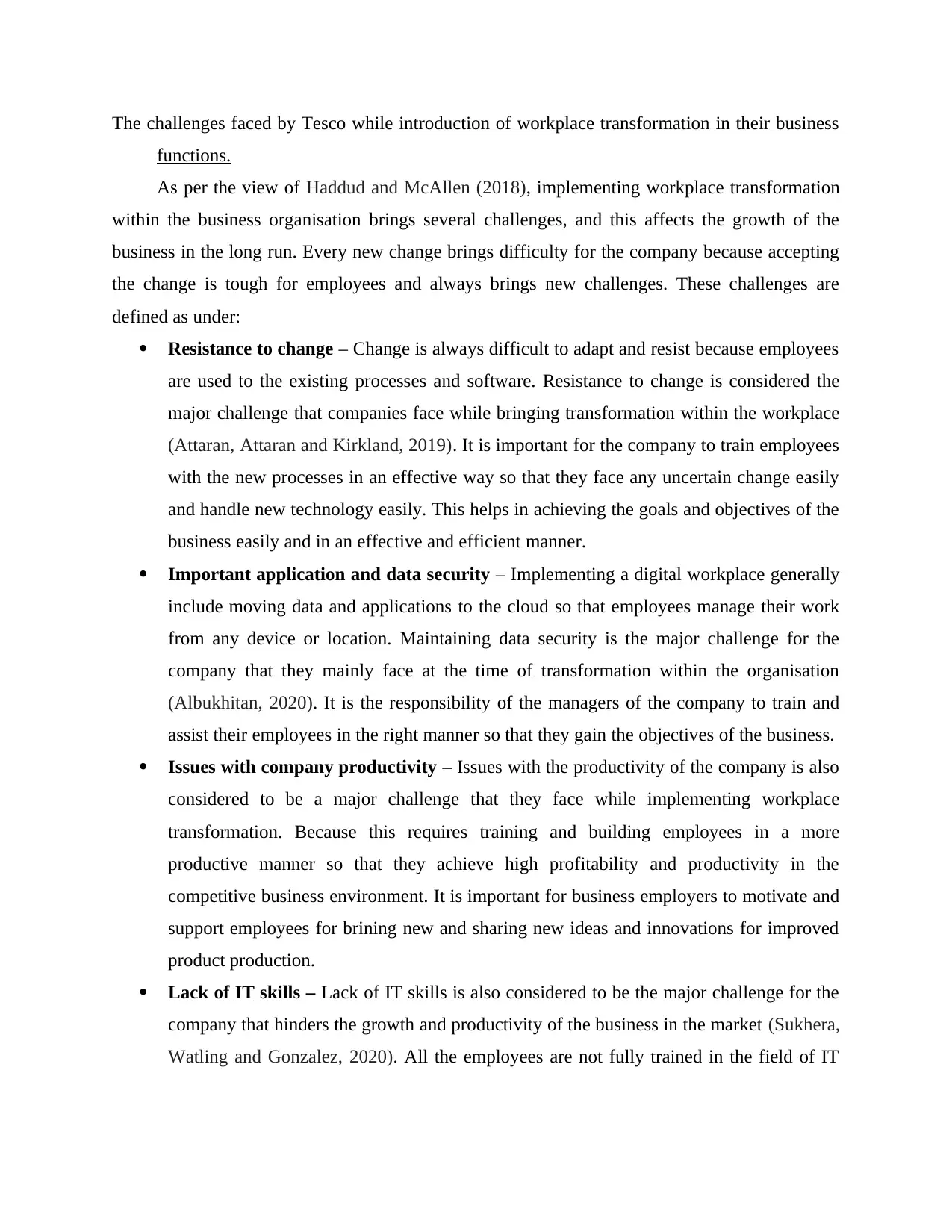
The challenges faced by Tesco while introduction of workplace transformation in their business
functions.
As per the view of Haddud and McAllen (2018), implementing workplace transformation
within the business organisation brings several challenges, and this affects the growth of the
business in the long run. Every new change brings difficulty for the company because accepting
the change is tough for employees and always brings new challenges. These challenges are
defined as under:
Resistance to change – Change is always difficult to adapt and resist because employees
are used to the existing processes and software. Resistance to change is considered the
major challenge that companies face while bringing transformation within the workplace
(Attaran, Attaran and Kirkland, 2019). It is important for the company to train employees
with the new processes in an effective way so that they face any uncertain change easily
and handle new technology easily. This helps in achieving the goals and objectives of the
business easily and in an effective and efficient manner.
Important application and data security – Implementing a digital workplace generally
include moving data and applications to the cloud so that employees manage their work
from any device or location. Maintaining data security is the major challenge for the
company that they mainly face at the time of transformation within the organisation
(Albukhitan, 2020). It is the responsibility of the managers of the company to train and
assist their employees in the right manner so that they gain the objectives of the business.
Issues with company productivity – Issues with the productivity of the company is also
considered to be a major challenge that they face while implementing workplace
transformation. Because this requires training and building employees in a more
productive manner so that they achieve high profitability and productivity in the
competitive business environment. It is important for business employers to motivate and
support employees for brining new and sharing new ideas and innovations for improved
product production.
Lack of IT skills – Lack of IT skills is also considered to be the major challenge for the
company that hinders the growth and productivity of the business in the market (Sukhera,
Watling and Gonzalez, 2020). All the employees are not fully trained in the field of IT
functions.
As per the view of Haddud and McAllen (2018), implementing workplace transformation
within the business organisation brings several challenges, and this affects the growth of the
business in the long run. Every new change brings difficulty for the company because accepting
the change is tough for employees and always brings new challenges. These challenges are
defined as under:
Resistance to change – Change is always difficult to adapt and resist because employees
are used to the existing processes and software. Resistance to change is considered the
major challenge that companies face while bringing transformation within the workplace
(Attaran, Attaran and Kirkland, 2019). It is important for the company to train employees
with the new processes in an effective way so that they face any uncertain change easily
and handle new technology easily. This helps in achieving the goals and objectives of the
business easily and in an effective and efficient manner.
Important application and data security – Implementing a digital workplace generally
include moving data and applications to the cloud so that employees manage their work
from any device or location. Maintaining data security is the major challenge for the
company that they mainly face at the time of transformation within the organisation
(Albukhitan, 2020). It is the responsibility of the managers of the company to train and
assist their employees in the right manner so that they gain the objectives of the business.
Issues with company productivity – Issues with the productivity of the company is also
considered to be a major challenge that they face while implementing workplace
transformation. Because this requires training and building employees in a more
productive manner so that they achieve high profitability and productivity in the
competitive business environment. It is important for business employers to motivate and
support employees for brining new and sharing new ideas and innovations for improved
product production.
Lack of IT skills – Lack of IT skills is also considered to be the major challenge for the
company that hinders the growth and productivity of the business in the market (Sukhera,
Watling and Gonzalez, 2020). All the employees are not fully trained in the field of IT
⊘ This is a preview!⊘
Do you want full access?
Subscribe today to unlock all pages.

Trusted by 1+ million students worldwide

and this requires efficient and effective training for all employees about basic software
and program.
and program.
Paraphrase This Document
Need a fresh take? Get an instant paraphrase of this document with our AI Paraphraser
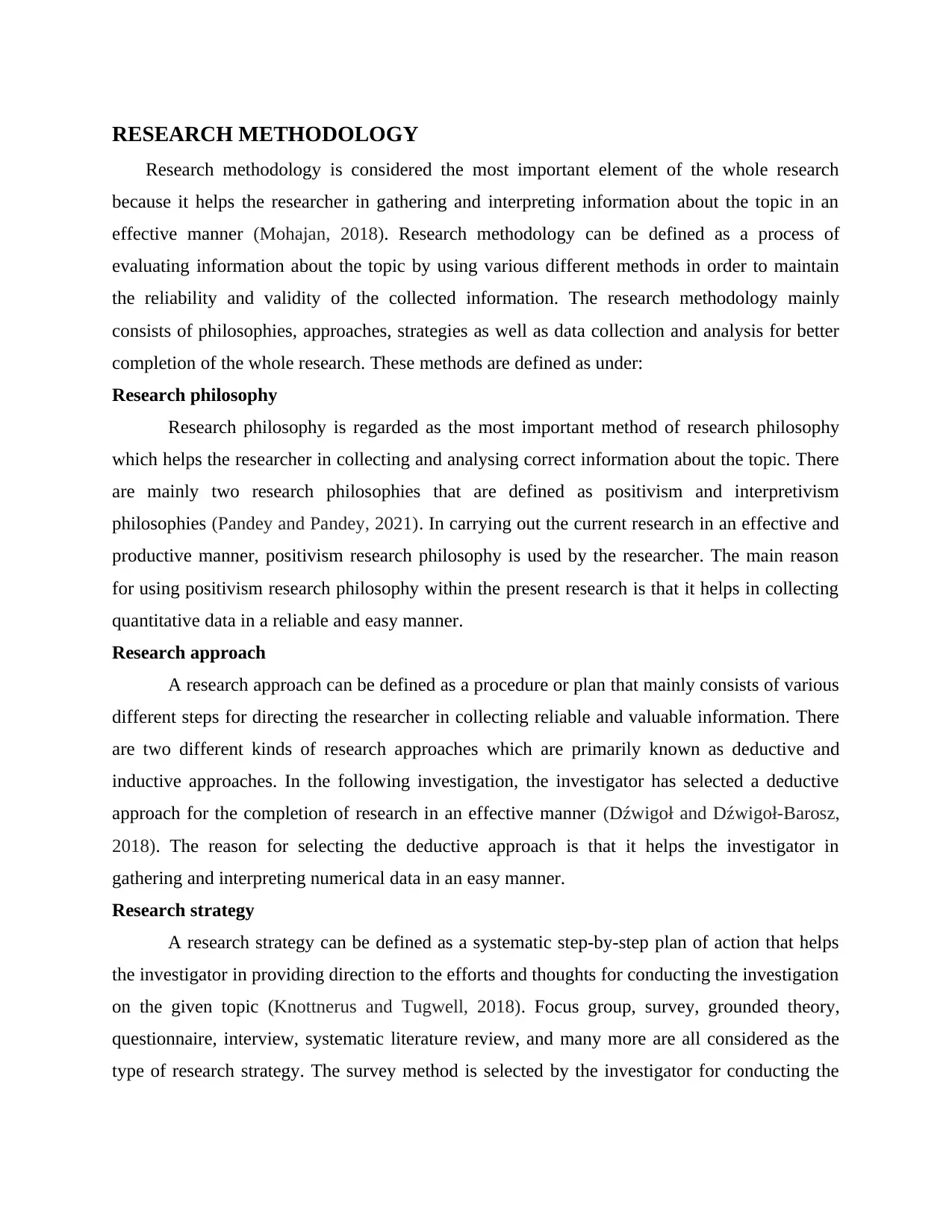
RESEARCH METHODOLOGY
Research methodology is considered the most important element of the whole research
because it helps the researcher in gathering and interpreting information about the topic in an
effective manner (Mohajan, 2018). Research methodology can be defined as a process of
evaluating information about the topic by using various different methods in order to maintain
the reliability and validity of the collected information. The research methodology mainly
consists of philosophies, approaches, strategies as well as data collection and analysis for better
completion of the whole research. These methods are defined as under:
Research philosophy
Research philosophy is regarded as the most important method of research philosophy
which helps the researcher in collecting and analysing correct information about the topic. There
are mainly two research philosophies that are defined as positivism and interpretivism
philosophies (Pandey and Pandey, 2021). In carrying out the current research in an effective and
productive manner, positivism research philosophy is used by the researcher. The main reason
for using positivism research philosophy within the present research is that it helps in collecting
quantitative data in a reliable and easy manner.
Research approach
A research approach can be defined as a procedure or plan that mainly consists of various
different steps for directing the researcher in collecting reliable and valuable information. There
are two different kinds of research approaches which are primarily known as deductive and
inductive approaches. In the following investigation, the investigator has selected a deductive
approach for the completion of research in an effective manner (Dźwigoł and Dźwigoł-Barosz,
2018). The reason for selecting the deductive approach is that it helps the investigator in
gathering and interpreting numerical data in an easy manner.
Research strategy
A research strategy can be defined as a systematic step-by-step plan of action that helps
the investigator in providing direction to the efforts and thoughts for conducting the investigation
on the given topic (Knottnerus and Tugwell, 2018). Focus group, survey, grounded theory,
questionnaire, interview, systematic literature review, and many more are all considered as the
type of research strategy. The survey method is selected by the investigator for conducting the
Research methodology is considered the most important element of the whole research
because it helps the researcher in gathering and interpreting information about the topic in an
effective manner (Mohajan, 2018). Research methodology can be defined as a process of
evaluating information about the topic by using various different methods in order to maintain
the reliability and validity of the collected information. The research methodology mainly
consists of philosophies, approaches, strategies as well as data collection and analysis for better
completion of the whole research. These methods are defined as under:
Research philosophy
Research philosophy is regarded as the most important method of research philosophy
which helps the researcher in collecting and analysing correct information about the topic. There
are mainly two research philosophies that are defined as positivism and interpretivism
philosophies (Pandey and Pandey, 2021). In carrying out the current research in an effective and
productive manner, positivism research philosophy is used by the researcher. The main reason
for using positivism research philosophy within the present research is that it helps in collecting
quantitative data in a reliable and easy manner.
Research approach
A research approach can be defined as a procedure or plan that mainly consists of various
different steps for directing the researcher in collecting reliable and valuable information. There
are two different kinds of research approaches which are primarily known as deductive and
inductive approaches. In the following investigation, the investigator has selected a deductive
approach for the completion of research in an effective manner (Dźwigoł and Dźwigoł-Barosz,
2018). The reason for selecting the deductive approach is that it helps the investigator in
gathering and interpreting numerical data in an easy manner.
Research strategy
A research strategy can be defined as a systematic step-by-step plan of action that helps
the investigator in providing direction to the efforts and thoughts for conducting the investigation
on the given topic (Knottnerus and Tugwell, 2018). Focus group, survey, grounded theory,
questionnaire, interview, systematic literature review, and many more are all considered as the
type of research strategy. The survey method is selected by the investigator for conducting the
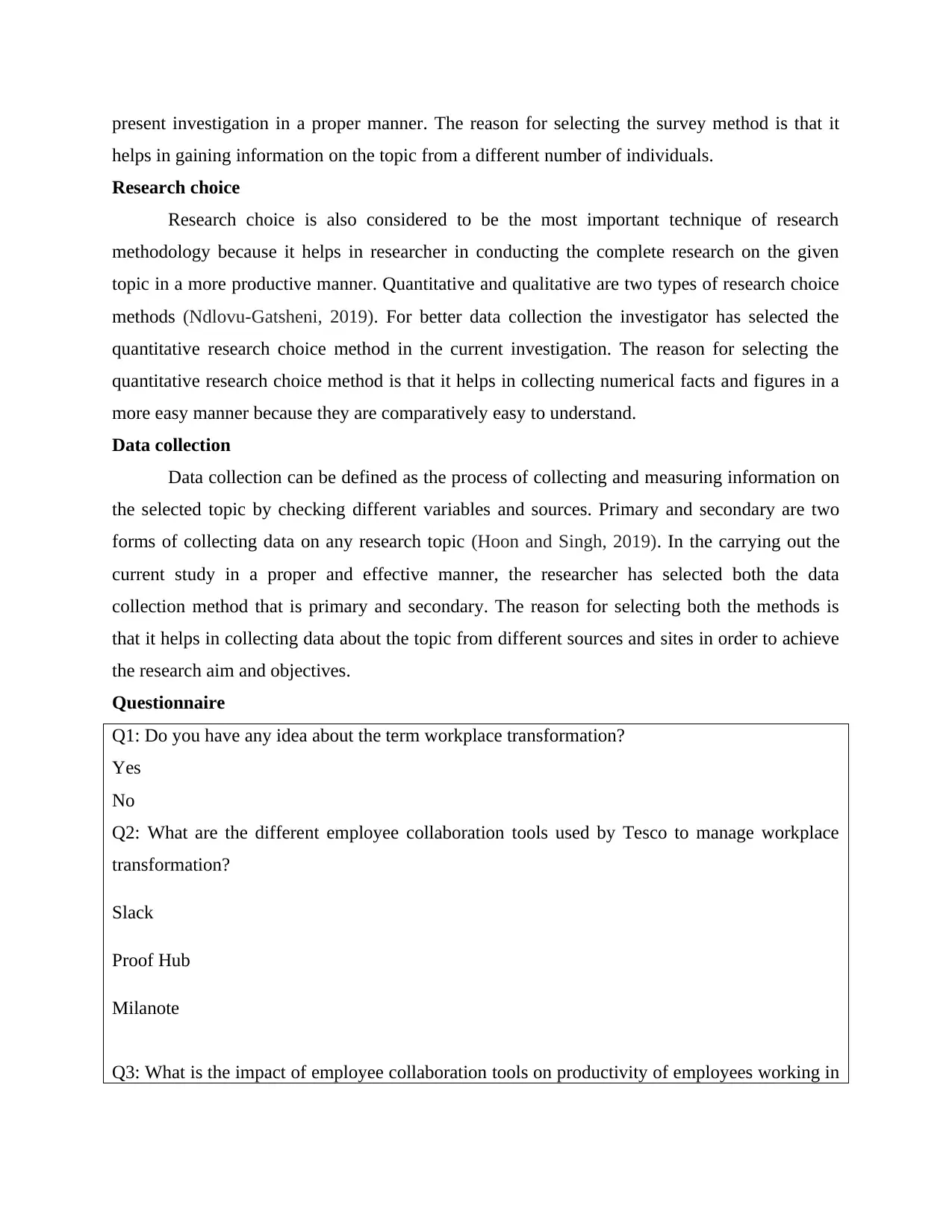
present investigation in a proper manner. The reason for selecting the survey method is that it
helps in gaining information on the topic from a different number of individuals.
Research choice
Research choice is also considered to be the most important technique of research
methodology because it helps in researcher in conducting the complete research on the given
topic in a more productive manner. Quantitative and qualitative are two types of research choice
methods (Ndlovu-Gatsheni, 2019). For better data collection the investigator has selected the
quantitative research choice method in the current investigation. The reason for selecting the
quantitative research choice method is that it helps in collecting numerical facts and figures in a
more easy manner because they are comparatively easy to understand.
Data collection
Data collection can be defined as the process of collecting and measuring information on
the selected topic by checking different variables and sources. Primary and secondary are two
forms of collecting data on any research topic (Hoon and Singh, 2019). In the carrying out the
current study in a proper and effective manner, the researcher has selected both the data
collection method that is primary and secondary. The reason for selecting both the methods is
that it helps in collecting data about the topic from different sources and sites in order to achieve
the research aim and objectives.
Questionnaire
Q1: Do you have any idea about the term workplace transformation?
Yes
No
Q2: What are the different employee collaboration tools used by Tesco to manage workplace
transformation?
Slack
Proof Hub
Milanote
Q3: What is the impact of employee collaboration tools on productivity of employees working in
helps in gaining information on the topic from a different number of individuals.
Research choice
Research choice is also considered to be the most important technique of research
methodology because it helps in researcher in conducting the complete research on the given
topic in a more productive manner. Quantitative and qualitative are two types of research choice
methods (Ndlovu-Gatsheni, 2019). For better data collection the investigator has selected the
quantitative research choice method in the current investigation. The reason for selecting the
quantitative research choice method is that it helps in collecting numerical facts and figures in a
more easy manner because they are comparatively easy to understand.
Data collection
Data collection can be defined as the process of collecting and measuring information on
the selected topic by checking different variables and sources. Primary and secondary are two
forms of collecting data on any research topic (Hoon and Singh, 2019). In the carrying out the
current study in a proper and effective manner, the researcher has selected both the data
collection method that is primary and secondary. The reason for selecting both the methods is
that it helps in collecting data about the topic from different sources and sites in order to achieve
the research aim and objectives.
Questionnaire
Q1: Do you have any idea about the term workplace transformation?
Yes
No
Q2: What are the different employee collaboration tools used by Tesco to manage workplace
transformation?
Slack
Proof Hub
Milanote
Q3: What is the impact of employee collaboration tools on productivity of employees working in
⊘ This is a preview!⊘
Do you want full access?
Subscribe today to unlock all pages.

Trusted by 1+ million students worldwide
1 out of 23
Related Documents
Your All-in-One AI-Powered Toolkit for Academic Success.
+13062052269
info@desklib.com
Available 24*7 on WhatsApp / Email
![[object Object]](/_next/static/media/star-bottom.7253800d.svg)
Unlock your academic potential
Copyright © 2020–2025 A2Z Services. All Rights Reserved. Developed and managed by ZUCOL.





